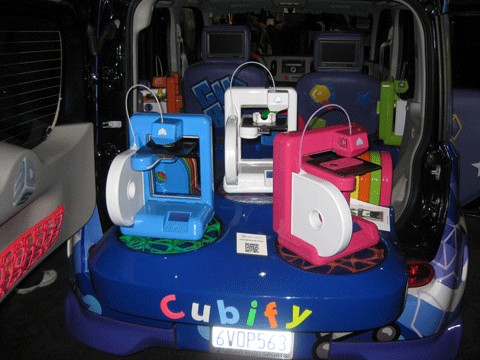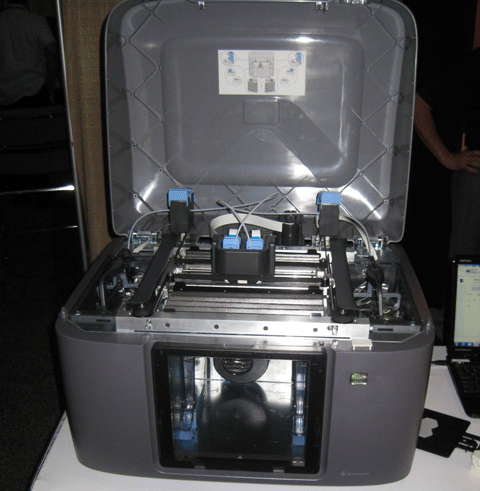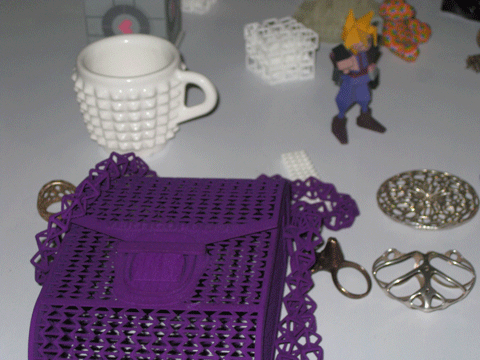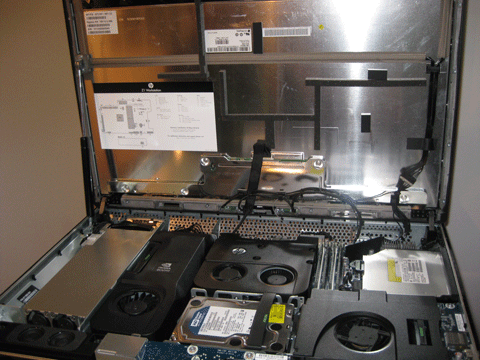InfiniteZ’s zSpace holographic design system
Some people who attend the SIGGRAPH computer graphics trade show year after year complain that there are no technology breakthroughs to be seen. Sometimes it’s true; all one sees are tweaks on long-standing formulas. But sometimes, like this year, you can be amazed at how certain technologies have been refined, improved and made user-friendly to the point where they are mind-boggling.
There are a few cases visible on the show floor at SIGGRAPH 2012 in Los Angeles this year. Most notably, zSpace by Infinite Z, which was reviewed by DEVELOP3D earlier this year.
For years, there have been systems that generate holographic images – and pretty good ones. But none has delivered a transformative experience. Up until now. The zSpace system does to holographic imaging what Netscape did to transform the web experience or what Apple did to change how you interact with content on your cell phone.
The initial visual “wow” you get from seeing truly 3D images on a flat-screen display, once the end point, is just the beginning with zSpace. The combination stylus and eye tracking brings objects alive and lets you get inside them. It’s no longer a spectator sport. Instead of being an outsider looking in, you’re a player.
You need to wear glasses to get the 3D volumetric effect in zSpace, but the glasses are light and comfortable. It only takes a minute to lose yourself in the experience. The combination of the stylus and eye tracking as input devices just feels right, and the glasses never distract.
What does this mean in design and engineering terms? It means being able to delve inside designs at a level only imagined a few years ago. It means being able to collaborate with greater depth and intuitive understanding – a feeling – that hasn’t existed up until now. And, as with all great technology, it means we are only sniffing at the potential – the applications will proliferate like rabbits in spring once people experience this stuff.
The video below, from the zSpace website, will seem hyperbolic when you watch it. But, for anyone who demoed zSpace at SIGGRAPH, it pales in comparison to the actual 3D interactive experience.
The eyes have it
Another technology we’ve seen for more than a decade is eye-tracking. It’s one of those interfaces that has been around for so long that geeks roll their eyes over it, which in this case might make a page of text scroll upwards or deliver you to a new country within a Google map.
The company at SIGGRAPH showing the progress and future of this technology is Tobii. Tobii calls the experience “gaze interaction.” I call it ground-breaking and practical, especially when teamed with back-end analysis tools.
Tobii has just started looking into design and engineering applications for its technology. The company is not new to the game, having been around since 2001. The combination of hardware and software used by Tobii has already enabled the company’s customers to conduct studies on website usability and to help people with disabilities interact with myriad applications just by moving their eyes. But the future holds so much more.
Think of being able to design a car dashboard based on the safest manner for people to gaze at critical gauges. How about changing machinery controls without lifting a finger? Or being able to design product packaging that puts instructions and key information in the best places for the user? Or designing an interface that enables a paraplegic person to work his or her way through a complex application? It’s not fantasy or science fiction – it’s here and very close now to practical integration into computing systems.
There’s a very good chance that eye tracking will become as integral a part of laptop and workstation interface design as touch screens and other sensory inputs.

The Cubify 3D printer is about the size of a coffee-maker and churns out physical objects made of ABS plastic
3D printing gets personal
For the last few years, SIGGRAPH has showcased technologies that excite attendees with the possibility of a 3D printer in every household. It’s hard to believe it will be like the proverbial chicken in every pot, but it’s conceivable that it could be almost as ubiquitous as desktop publishing software. Just as desktop publishing became much more democratic with an abundance of reasonably priced, relatively easy-to-use software, so is 3D printing starting to lower the bar to entry.
Two products at SIGGRAPH show just how close we are getting to providing 3D printing for those who want it.
One model comes from Cubify, a business unit of 3D Systems, the pioneer in rapid prototyping. It’s called the Cube Home 3D Printer and lists at $1,300 U.S. dollars. The machine, about the size of a coffee-maker, churns out physical objects made of ABS plastic, the same material used for Lego pieces.
Like its big brothers in the professional design world, the Cube Home 3D Printer prints from STL files, either from designs created on popular CAD packages or from designs that can be found on www.cubify.com
The Cube Home 3D Printer uses a $50 ABS cartridge that looks like a miniature barbell weight and can produce approximately 25 objects that measure a maximum of 5-1/2 cubic inches.
Another option on the SIGGRAPH show floor for personalized 3D printing is the Mojo 3D Printer from Stratasys, available for $9,900 or through a five-year lease for $185 a month. It also uses ABS plastic and its print size is 5 cubic inches. The print engine and materials come as a package and provide 80 cubic inches of material per pack for $400.

The Mojo 3D Printer also uses ABS plastic and its print size is 5 cubic inches
Automatic for the people
Maybe you don’t want a piece of hardware to output customised products cluttering up your home. But you do like the idea of customised products, whether in quantities of one or one hundred. That’s why the cloud was invented, and why Shapeways has used it as a vehicle to deliver individualised products to the masses.
Want that one-of-a-kind tea cup, action figure or change purse? Shapeways can deliver it, from your design or from a designer of your choice on the Shapeways website.
As of January 2012, the online service, based in New York and Eindhoven, Netherlands, has produced more than a million objects with 30 different material options for 150,000 users worldwide. This is the company’s third year at SIGGRAPH, but the first where it has come armed with a critical mass behind it.

Shapeways can deliver individualised products to the masses
Don’t diss incremental
Not every innovation needs to be disruptive. There’s beauty in incremental improvements. That’s what HP has done with the Z1 workstation.
The HP Z1 workstation came out in February, but was on display for the first time at SIGGRAPH. It takes the all-in-one design of the iMac and makes it professional-level, with an Nvidia Quadro 4000M card delivering the graphics power.
Best yet, it brings a level of customisation and easy maintenance that makes the iMac look stingy. Whereas it can take hours to simply change out a hard drive in the iMac, a hard drive or graphics card can be exchanged in the Z1 within seconds.
This is definitely not a revolution, but for design professionals for whom time is money is much more than a cliché, it’s gold.
DEVELOP3D reviewed the HP Z1 earlier this year.

Interior of an HP Z1: a serviceable, all-in-one workstation
More from the show floor tomorrow
Rendering your world just keeps getting better, faster, easier and more collaborative.
Bob Cramblitt (www.cramco.com) writes about developments in CAD/CAM and computer graphics that can make a definitive difference for design and engineering professionals.





